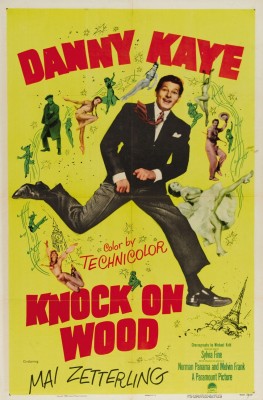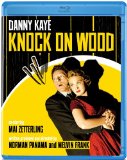| Reviews & Columns |
|
Reviews DVD TV on DVD Blu-ray 4K UHD International DVDs In Theaters Reviews by Studio Video Games Features Collector Series DVDs Easter Egg Database Interviews DVD Talk Radio Feature Articles Columns Anime Talk DVD Savant Horror DVDs The M.O.D. Squad Art House HD Talk Silent DVD
|
DVD Talk Forum |
|
|
| Resources |
|
DVD Price Search Customer Service #'s RCE Info Links |
|
Columns
|
|
|
Knock on Wood
Like the concurrently released My Favorite Spy, Knock On Wood is a Paramount-licensed title Olive Films previously released to DVD format only, the label now catching up with many of these older titles and upgrading them to Blu-ray. And, like My Favorite Spy, Knock on Wood definitely looks a bit better in high-def, though perhaps not so much better that those who already have the DVD will want to drop it in the trash and upgrade to Blu.
Jerry Morgan (Kaye) is a ventriloquist engaged to Audrey Greene (Virginia Huston) but while on stage Jerry's dummy Clarence - who resembles Kaye but, oddly, also comedian Harry Ritz - lets loose a string of hurtful, passive-aggressive insults, leaving the audience nonplussed. In the tradition of Dead of Night, Clarence seems to be taking control of Jerry's personality, and Jerry smashes the dummy's face in response. Marty (David Burns), his friend and manager, compels Jerry to visit Dr. Krueger, an eminent psychiatrist.
Meanwhile, two sets of villains are after the blueprints to Lafayette X.V. 27, a top-secret whatsit. Godfrey Langstrom (Torin Thatcher) is a respected British philanthropist but actually secretly selling intelligence to the highest bidder. Brodnik (Otto Waldis) is a Soviet spy in all but name and also after the plans. He gets ahold of them first, hiding them in the wooden heads of Jerry's two newly repaired dummies, Clarence and Terrance.
In a plane bound for London, there's a funny scene with Langston, believing Jerry is a courier working for the Commies, subtly offering him a million dollars for the blueprints, though Jerry thinks Langston is talking about something else. Aboard the same plane, Jerry has an unusually good meet-cute scene with Ilse Nordstrom (Mai Zetterling), who turns up later as the psychiatrist Dr. Krueger assigns to the case.
She tries to cure Jerry but he's too busy falling in love with her to care. Meanwhile, the spies converge on Jerry at his hotel.
At 103 minutes, Knock on Wood is overlong and rarely laugh-out-loud funny but consistently enjoyable. The picture is a bit disjointed: Jerry's psychological problems, stemming from vaguely abusive, alcoholic parents (Kaye also plays his own father in one scene) and his weird relationship with Audrey and Clarence are played straight for the most part, and at times are almost squirmily uncomfortable. (Reader Sergei Hasenecz helpfully points out that Kaye's character quirks are given a psychological explanation in several films.) Jerry deflects any critical analysis by shifting the focus to Ilse, and her feelings of guilt for having survived her soldier husband during the war. None of this leads anywhere, particularly, and except for a brief gag near the end Panama and Frank underutilize Jerry's skills as a ventriloquist.
But there are many funny scenes, Kaye delivering some especially well-timed physical gags with Zetterling aboard the plane in that meet-cute scene; in the final reels, when Jerry attempts to demonstrate a high-tech sports car that goes berserk; and at the end, when Kaye becomes the reluctant principal in a ballet wittily choreographed by Kidd. He also gets to sing several wordplay songs written by wife Sylvia Fine, including the amusing "Monahan O'Han," which Kaye performs with a thick Irish brogue.
The cast is also especially good and somewhat unusual. The beautiful, Swedish-born Zetterling was one of the first international stars to emerge from Ingmar Bergman's troupe of actors, and her subsequent success in British films led to a brief Hollywood career before her liberal politics sent her packing back to England. (Among the many fine films she made during this period is Seven Waves Away, known as Abandon Ship! in the U.S., a better, grimmer variation of Lifeboat.) Zetterling turned to directing in the 1960s, influenced by Bergman and often featuring actors associated with his films (Bibi Andersson, etc.), but which were also so sexually explicit and taboo several were banned outright from competition at the Venice and Cannes film festivals. She started acting again and is probably best known to younger generations as the kindly grandmother in Nicholas Roeg's delightful film of Roald Dahl's The Witches (1990). She died four years later.
Also exceptional is David Burns, who gives a funny, nuanced performance as Marty, Jerry's manager. A legend on Broadway, Burns won Tony Awards appearing in the original productions of The Music Man and A Funny Thing Happened on the Way to the Forum, and also introduced the song "It Takes a Woman" from Hello, Dolly! - but he made few films. (He plays Tim the barkeep in It's Always Fair Weather, which co-starred Michael Kidd, for instance. One of his best recorded performances was as Ralph Kramden's rich Uncle Howard in an episode of "The Color Honeymooners," from 1969.)
Torin Thatcher (The 7th Voyage of Sinbad) makes a good foil for Kaye, somewhat anticipating Basil Rathbone's function in The Court Jester a few years later.
Filmed in Technicolor, Knock on Wood is fairly lavish, probably costing in the $3-4 million range, but it's also quite obvious Kaye is doubled for all of the second-unit location footage in London, though Mai Zetterling is visible in these scenes.
Video & Audio
Knock on Wood premiered in April 1954, well into the widescreen revolution, but prior to the premiere of Paramount's premium VistaVision process. As a result, this was shot in three-strip Technicolor but formatted for widescreen, probably 1.66:1. The titles are slightly pillar-boxed, to 1.66:1, though the rest of the film is 1.78:1. In any case the image looks reasonably framed throughout and is generally fine, despite some color flashing, misaligned matrixes, and other minor damage. The DTS-HD Master Audio mono audio soundtrack (English only, no subtitle options) is in a similar state, the sound a bit wobbly here and there but generally okay. There are no Extra Features.
Parting Thoughts
A pleasant star vehicle, Knock on Wood is a funny family film that holds up well today. If you already have the DVD, you probably won't feel the need to upgrade but, if not, by all means seek out the Blu-ray. Recommended.
Stuart Galbraith IV is a Kyoto-based film historian whose work includes film history books, DVD and Blu-ray audio commentaries and special features. Visit Stuart's Cine Blogarama here.
|
| Popular Reviews |
| Sponsored Links |
|
|
| Sponsored Links |
|
|
| Release List | Reviews | Shop | Newsletter | Forum | DVD Giveaways | Blu-Ray | Advertise |
|
Copyright 2024 DVDTalk.com All Rights Reserved. Legal Info, Privacy Policy, Terms of Use,
Manage Preferences,
Your Privacy Choices | |||||||














